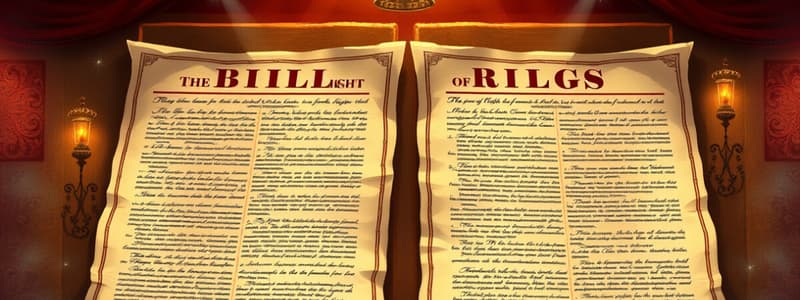Podcast
Questions and Answers
The English Bill of Rights was signed into law in ______ by William III and Mary II.
The English Bill of Rights was signed into law in ______ by William III and Mary II.
1689
The Glorious Revolution involved the ousting of King ______ II.
The Glorious Revolution involved the ousting of King ______ II.
James
William and Mary formed a joint ______ after the Glorious Revolution.
William and Mary formed a joint ______ after the Glorious Revolution.
monarchy
The new Parliament summoned by William was known as the ______.
The new Parliament summoned by William was known as the ______.
The English Bill of Rights is credited as an inspiration for the U.S. ______ of Rights.
The English Bill of Rights is credited as an inspiration for the U.S. ______ of Rights.
The English Bill of Rights condemned King James II for abusing his ______.
The English Bill of Rights condemned King James II for abusing his ______.
The Bill of Rights created a constitutional ______ in England.
The Bill of Rights created a constitutional ______ in England.
One of the key liberties established was the freedom to bear ______ for self-defence.
One of the key liberties established was the freedom to bear ______ for self-defence.
The Bill of Rights includes 13 articles that outline specific ______.
The Bill of Rights includes 13 articles that outline specific ______.
The English Bill of Rights has influenced laws and ideologies in countries like the ______, Canada, and Australia.
The English Bill of Rights has influenced laws and ideologies in countries like the ______, Canada, and Australia.
Flashcards are hidden until you start studying
Study Notes
English Bill of Rights
- Signed into law in 1689 by co-rulers William III and Mary II following the overthrow of King James II.
- Established constitutional and civil rights, giving Parliament authority over the monarchy.
- Recognized as foundational for a constitutional monarchy in England and an inspiration for the U.S. Bill of Rights.
Glorious Revolution
- Occurred from 1688-1689, leading to King James II's ousting due to political and religious tensions.
- Citizens distrusted James II for being Catholic and exercising absolute power.
- Protestants opposed James II's rule, leading to the rise of his Protestant daughter Mary and her husband William of Orange.
- William formed a joint monarchy with Mary, granting more rights to Parliament.
- The ‘Convention’ Parliament declared that James II had abdicated by violating contracts with the people.
Key Events of the Revolution
- On 22 January 1689, the Convention convened, asserting James II’s abandonment of the government.
- On 13 February 1689, both Houses of Parliament offered the Crown to William and Mary along with the Declaration of Rights, making it conditional on their acceptance.
- The English Bill of Rights was incorporated into an Act of Parliament, detailing the rights of subjects.
Provisions of the English Bill of Rights
- Declared illegal actions by the Crown, including:
- Suspending laws without Parliament’s consent.
- Levying taxes without parliamentary approval.
- Raising an army during peacetime without consent.
- Emphasized individual rights, including:
- Freedom to elect Parliament members without interference.
- Freedom of speech and petition.
- Right to bear arms for self-defense.
- Protection from cruel punishment and excessive bail.
- No taxation without Parliament’s consent.
- Declared that Roman Catholics could not inherit the throne and confirmed the succession to Mary’s sister, Princess Anne.
Constitutional Monarchy
- The Bill established a constitutional monarchy, limiting the monarch's power and ensuring the head of state relies on Parliament's consent.
- Modern British monarchy is largely ceremonial, with the Bill of Rights enhancing individual rights.
Legacy of the English Bill of Rights
- Significantly impacted governance in England and influenced democratic frameworks in the U.S., Canada, Australia, and more.
- Contributed to the evolution of government roles and citizen rights, shaping the structure of modern democracies.
- The Bill of Rights parallels the Magna Carta in limiting monarchal power and democratizing governance.
Studying That Suits You
Use AI to generate personalized quizzes and flashcards to suit your learning preferences.




